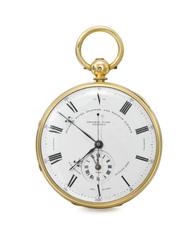







A month-going astronomical longcase clock by Roland Jarvis, 1982, Hastings. The case is veneered in ebonised fruitwood on a carcase of marine plywood, with lacquered brass stringing and edging and teardrop shaped glazing to the trunk door. The dial is composed of 2 larger and 2 smaller sub-dials. The topmost dial is formed of a planetarium, giving the relative positions of the 8 major planets and the moon. The left-hand dial shows local time and the day of the week. The right-hand dial is a perpetual calendar, indicating the day of the month, the month and the sequence of leap year. The lower dial displays the following information; hour, minutes and seconds hands for Greenwich mean time; the moon's age and phase as well as its position relative to the zodiac; the sun's position relative to the zodiac; a double ended lunar nodal hand; an annual calendar; time of sunrise and sunset indicated by spoon-shaped hands; an adjustable tidal hand; and a state of wind indicator.
The movement has a fifteen-second remontoire and deadbeat escapement. All indications of the clock are driven from a single fusee and mainspring. The planetarium can be disconnected from the clock and advanced manually for demonstration purposes. The pendulum is formed of a steel and aluminum gridiron, which also displays the temperature in fahrenheit. It has a large lenticular bob and a double spring suspension.
The artist Roland Jarvis (1926-2016) originally studied engineeing at King's College London. In his 20's he studied art at Chelsea School of Art and in Paris. He taught at Camberwell, before moving to Hastings in 1982. Jarvis discovered clockmaking in his 40's, and found a particular interest in making clocks with astronomical complications. In his lifetime his clocks were exhibited at the Science Museum, the Crafts Council and the Prescot Museum. In 1987 the Worshipful Company of Clockmakers’ put on an exhibition of Modern British Clock and Watchmaking at the Goldsmiths’ Hall, in which Jarvis featured. Here Jarvis received an award from the Company for excellence in horology. Four years later he won second place in another competition for excellence put on by the Worshipful Company of Clockmakers. Clockmakers' Museum No. 1510
Details
- Category:
- Clockmakers
- Collection:
- The Worshipful Company of Clockmakers
- Object Number:
- L2019-483
- Materials:
- brass (copper, zinc alloy), lead (metal), steel (metal), aluminium (metal), ebonised wood and glass
- Measurements:
-
overall: 1970 mm x 440 mm x 220 mm,
- type:
- regulator
- credit:
- Lent by the Worshipful Company of Clockmakers




